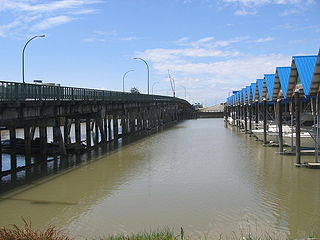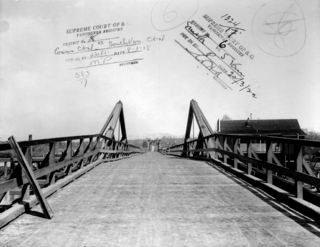
Canadian Pacific Hotels (CPH) was a division of the Canadian Pacific Railway (CPR) that primarily operated hotels across Canada, since passenger revenue made a significant contribution to early railway profitability. CPR restructured the division as a subsidiary in 1963. In 1988, CPR purchased the Canadian National Hotels chain, making Canadian Pacific Hotels and Resorts the nation's largest hotel owner. In 1998, all CPH properties were branded as either Fairmont or Delta.

Arthur Laing,, a Canadian politician, was actively involved with the BC Liberals, but his primary achievements were federally as a Liberal member of parliament. He served in the cabinets of prime ministers Lester B. Pearson and Pierre Trudeau.
Spuzzum is an unincorporated community in the lower Fraser Canyon area of southwestern British Columbia, Canada. The place is on the west shore of the Fraser River and north shore of Spuzzum Creek. The locality, on BC Highway 1, is by road about 40 kilometres (25 mi) north of Hope and 69 kilometres (43 mi) south of Lytton.

Delta Hotels by Marriott is a four-star brand of hotels and resorts located primarily in North America.

Sicamous is a district municipality in the Shuswap Country region of south central British Columbia. The place is adjacent to the narrows, which is the confluence of Mara Lake into Shuswap Lake. At the BC Highway 97A intersection on BC Highway 1, the locality is by road about 73 kilometres (45 mi) west of Revelstoke, 140 kilometres (87 mi) east of Kamloops, and 75 kilometres (47 mi) north of Vernon.

The Arthur Laing Bridge is a crossing over the north arm of the Fraser River, and several minor roads, in Metro Vancouver.

The Knight Street Bridge is a crossing over the north arm of the Fraser River, the Canadian National Railway (CNR) line, and several roads, in Metro Vancouver.
Union Bay is an unincorporated community located south of Hart Creek on the east coast of central Vancouver Island, British Columbia. This Comox Valley community on BC Highway 19A is by road about 93 kilometres (58 mi) north of Nanaimo, and 14 kilometres (9 mi) south of Courtenay.

Alexandra Bridge Park lies within the lower Fraser Canyon of British Columbia, Canada. This provincial park is adjacent to the historic suspension bridge from 1926, which spans the Fraser River and was built using the eastern abutment of the bridge from 1863. The locality, on BC Highway 1, is by road about 44 kilometres (27 mi) north of Hope and 65 kilometres (40 mi) south of Lytton.

The Moray Bridge, also known as the Moray Channel Bridge, and formerly the Middle Arm Bridge, is a crossing over the middle arm of the Fraser River in Metro Vancouver. Richard Moody, who would name geographical features, such as this channel, after acquaintances, honoured Jonathan Moray (1824–84), a sergeant in the Corps of Royal Engineers, and later the New Westminster police chief.

The Dinsmore Bridge is a crossing over the middle arm of the Fraser River, and a former section of River Rd., in Metro Vancouver.

The Marpole CP Rail Bridge is a partially dismantled crossing over the north arm of the Fraser River, and River Dr., in Metro Vancouver.

The Mission Bridge is a steel and concrete girder bridge across the Fraser River in the Fraser Valley region of southwestern British Columbia, Canada. Linking the City Of Mission and the City of Abbotsford, the four-lane structure carries BC Highway 11.
Donald is an unincorporated community in the East Kootenay region of southeastern British Columbia. This almost ghost town is on the northeast shore of the Columbia River immediately southeast of the mouth of Marl Creek. The locality, on BC Highway 1, is by road about 28 kilometres (17 mi) northwest of Golden and 122 kilometres (76 mi) northeast of Revelstoke.
The Agassiz–Rosedale Bridge is a cantilever truss bridge across the Fraser River in the Fraser Valley region of southwestern British Columbia. Linking Agassiz with the south shore, the two-lane bridge carrying BC Highway 9 is by road about 36 kilometres (22 mi) west of Hope, 119 kilometres (74 mi) east of Vancouver, and 51 kilometres (32 mi) east of Abbotsford.
The Alexandra Bridge is a steel arch bridge across the Fraser River in the lower Fraser Canyon area of southwestern British Columbia, Canada. The two-lane crossing, carrying BC Highway 1, is by road about 44 kilometres (27 mi) north of Hope and 66 kilometres (41 mi) south of Lytton.
A series of ferries and bridges have crossed the Fraser River in the vicinity of Lillooet in the Squamish-Lillooet region of southwestern British Columbia. From the 1850s, these crossings have connected both north–south and local traffic.

The Ladner Ferry was a crossing of the south arm of the Fraser River in Metro Vancouver, linking Ladner with Richmond. It operated from 1913 until 1959, when it was replaced by the George Massey Tunnel.
The Marpole Bridge (1889–1957), a.k.a. Eburne Bridge, North Arm Bridge, Sea Island Bridge, or Middle Arm Bridge, was consecutive crossings over the north and middle arms of the Fraser River in Metro Vancouver.

The Fraser St. Bridge (1894–1974), also known as the Fraser Ave. Bridge, North Arm Bridge, No. 5 Rd. Bridge, or Twigg Island Bridge, was a crossing over the north arm of the Fraser River in Metro Vancouver.
















